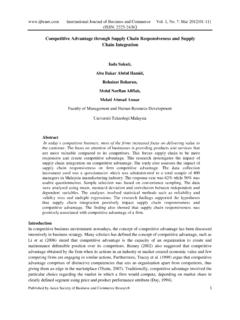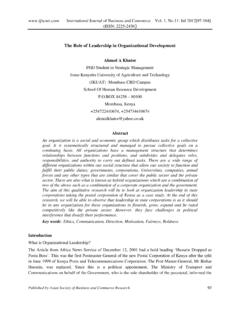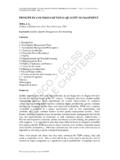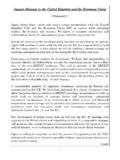Transcription of Analysis of Kaizen Implementation in Northern …
1 International Journal of business and Commerce Vol. 3, : Apr 2014[39-57] (ISSN: 2225-2436) Published by Asian Society of business and Commerce Research 39 Analysis of Kaizen Implementation in Northern Ethiopia s Manufacturing Industries Asayehgn Desta Sarlo Distinguished Professor of Sustainable Economic Development, Dominican University of California Hadush Berhe Asgedom, Alula Gebresas & Mengstu Asheber Lecturer Industrial Engineering Program; Makelle University, Tigrai, Ethiopia Abstract The Kaizen manufacturing processes in Japan have revolutionized the way enterprises deliver products to their customers. Given ambitions to advance, retain market share, and satisfy their domestic market while expanding into the international market, it has become a dream for many manufacturing companies similar to Japanese manufacturing enterprises to build a culture of continuous improvement.
2 In other words, a number of foreign companies are striving to acquire the habit of improvement using Kaizen , as well as to focus on a customer-driven strategy to improve productivity and the quality of products and services by continuously amassing marginal improvements over time. Mapping out a survey questionnaire, interviews, direct observation of the personnel who were directly involved with the Implementation process, the effects of the newly introduced Kaizen techniques at three case factories from the Northern Ethiopia were assessed. Based on key performance indicators that specifically relate to inputs, outputs and process factors of the Kaizen management system the three pilot case companies were assessed to determine if 1) top managers and employees have a genuine concern for the short and long-term health of the company, 2) the companies work teams have a mindset for action, 3) employees are committed to the companies value systems, and 5) the employees suggestions are used as leverage for improvement in the production process.
3 The study found that the three pilot companies have reduced the costs of production, improved quality, reduced lead time, improved customers satisfaction and have partially achieved three out of five (5S) Kaizen steps: sorting, setting, and shining, but they have not yet achieved how to standardize and sustain self-discipline. The study also established that the executives of the three pilot cases don t seem to be committed to the Kaizen teamwork. Though vital for continuous improvement, the front line workers are rarely asked to participate as a team. Key words: Kaizen , customer-driven strategy, value system, leverage for improvement Introduction Faced with emerging global competition and substantial changes in consumer needs, desires, and tastes, a number of enterprises today are using the Japanese management system known as Kaizen to International Journal of business and Commerce Vol.
4 3, : Apr 2014[39-57] (ISSN: 2225-2436) Published by Asian Society of business and Commerce Research 40 make adjustments to re-engineer their manufacturing processes to meet these needs. The dynamic Kaizen strategy is an activity of continually revolving cycles of Plan, Do, Check and Act (PDCA) which focus on customer-driven processes to improve productivity and the quality of products and services by amassing marginal improvements over time. A number of manufacturing industries in Ethiopia currently are not using methods that will achieve high productivity and excellent quality standards to make them more competitive in the globalized, international markets.
5 Most of the initiatives taken for quality and productivity improvement are through top-down approaches without the best management skills. Many manufacturing companies are plagued by such problems as high quality rejects, high inventories, long lead time of production, high costs of production, and inability to cope with customer orders. Given these problems and appreciating that Kaizen , the manufacturing process used in Japan, has revolutionized the way enterprises deliver products to their customers, retain market share, and satisfy their domestic market and expand into the international market, a number of enterprises in Northern Ethiopia are attempting to develop the habits of Kaizen to focus on a customer-driven strategy to improve productivity and the quality of products and services by continuously amassing marginal improvements over time.
6 The Implementation of the Kaizen management techniques could enable enterprises in Northern Ethiopia to identify and solve their current manufacturing problems without employing high-tech approaches, only involving people on the shop floor in Kaizen activities. Three pilot companies have been studied, the Mesfin Industrial Engineering PLC, Almeda Textile Factory PLC., and Sheba Leather and Tanning Industry PLC, which have implemented the Kaizen management system to revitalize their management system. Thus, the central question of the study is: How efficient and effective are the Kaizen strategic management initiatives, tools, and methods for improvement in these three pilot projects in Northern Ethiopia? The purpose of this study is to: 1) map out the degree of awareness of three companies of the Kaizen management strategy, 2) assess the mindset for action in the working teams of the three companies, 3) measure the institutionalization of the Kaizen process to ensure continuous improvement in the production of quality products and services, 4) investigate how the organizational structure of the three companies accepts employee inputs and leverages their suggestions for improvement, 5) analyze the commitment of top managers at the three companies to the short and long-term health of their enterprises.
7 The awareness of Kaizen , its Implementation process, and the effects of using this strategic management system in the three companies are measured through performance indicators generated from questionnaires, interviews, direct observation, factory developed metric systems, and published records by the companies resource planning and research centers. Review of the Literature From the ashes of the Second World War, Japan through its culturally embedded, innovative management system has succeeded in rebuilding its economy and is now emulated by the community of nations (Waheed et al., 2010). For example, in the 1980s, the manufacturing industry in Japan showed significant growth through the adoption of the Kaizen process of management strategies. Its key objective has been to embed the process into the work culture to achieve a never-ending drive toward increasing productivity, International Journal of business and Commerce Vol.
8 3, : Apr 2014[39-57] (ISSN: 2225-2436) Published by Asian Society of business and Commerce Research 41 efficiency, and quality improvement. Today, the Kaizen management system is spreading throughout the world. It has become a goal for many manufacturing companies to build a culture of continuous commitment to improvement. Many non-Japanese companies are initiating a Kaizen management strategy without adequately taking into consideration its own cultural roots. Thus, they face many barriers while they are chasing this dream. As stated by Brunet and New (2003), it has not been clear hitherto how firms in other cultures can maintain the momentum for Kaizen activities, nor how the concepts of target setting, control and incentives for participants fit into their overall management system.
9 The Toyota Total Production System (TPS) sees problems as opportunities to improve, seeking root causes by asking what, why, and who questions. Companies from other cultures visualize problems as discrepancies between the current situation and the standardized ideal that can only be solved by management. In addition, while the Toyota TPS, sees that qualities are customer driven, other cultures view that whatever they supply to the market can be sold, thinking they have produced to the needs of consumers (see for example, Ohno, T. and Bodek, N, 1988; EPA, November 200; and Ahmed,S; Hasan,M; Fen,Y, 2005). Despite these glaring and challenging problems, in order to stay competitive in an increasingly global market place and with an increase in customer demands, a number of foreign companies are forced to rethink their manufacturing and management approach to lower costs of production, minimize waste, improve productivity, boost quality, and achieve sustainability.
10 Thus, if top management of Kaizen companies in other cultures has the desire to thrive for a healthy long term, before starting on a Kaizen transition, management needs to be passionately committed to undertaking an assessment of its own internal and external conditions. Also, it needs to see if it has tailored its activities to meet domestic and global customers. In addition, when transferred to other cultures, companies need to use dedicated cross-functional teams to improve a targeted manufacturing work area (Melnyk et al., 1998, Kirby and Greene, 2003, and Heizer & Render, 2010). Therefore, since well established Kaizen strategies help companies to control cost, minimize workers motion, focus on zero defects and, more fundamentally, improve workers skills by creating a cooperative atmosphere where everyone becomes fully aware of the key goals, each step of the Kaizen process needs to be mapped out and measured to ensure economic value to its customers.













